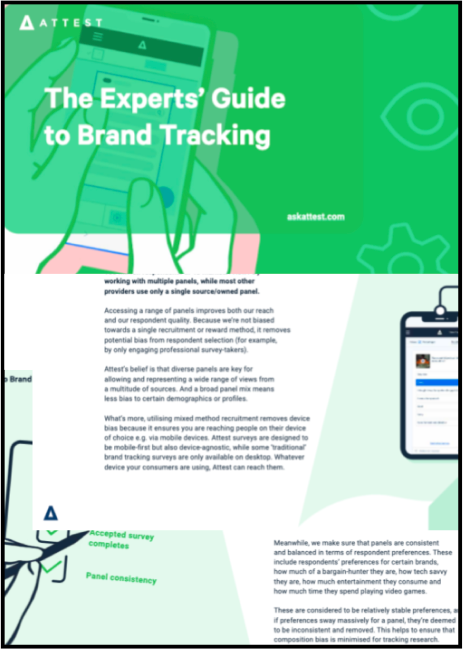What is brand perception? How to measure and improve it

Do you know what your customers think your brand represents? You should. Find out how to measure brand perception and what you can do with the insights.
- How to measure brand perception and why you should
- What is brand perception?
- Why is brand perception measurement important?
- What affects brand perception
- 3 Strategies to measure brand perception
- How to measure brand perception in-house
- How to use brand perception measurement insights to make improvements
- Understand consumer brand perception: ask Attest!
How to measure brand perception and why you should
People’s opinions shape the landscape of the market you’re in. Even if you know for a fact that your products are of higher quality, your brand perception is what will influence people’s choice – you, or your competitor.
It’s crucial to understand what people really think about your brand and whether that’s aligned with your desired brand perception and brand style.
In this article, we’ll dive into how you can identify the gap between the two, why you should, and how you use that information moving forward.
What is brand perception?
Brand perception defines what consumers think your brand, your products and your services represent. It’s how your brand makes them feel.
Brand perception is much more than just an opinion. It’s a feeling, often one that people subconsciously have, towards your brand. How do customers perceive you, really?
It’s formed by your branding, your brand messaging, but also what others say about you. Plus, it’s relative to your competitors’ perception.
There’s a lot that influences brand perception, which we’ll dive into later. But it’s important to understand that it’s what your customers believe you stand for – not what you’re trying to be. In an ideal world, these two are the same. In reality, this is something you should continuously work on.
And good reputation, positive brand perception and solid brand equity can influence a lot more than you think. Often, a bad reputation can’t be forgotten with huge discounts.
Brand perception affects the type of customers you attract, the prices you can ask and the partnerships you can build with other brands, such as stores where your product is sold.

Look at Facebook. It started out as a platform for university students. Now, it’s the place to be for people (mostly older generations, as our research shows) to connect, and it’s built up quite the negative reputation along the way.
While Zuckerberg wants Facebook to stand for connection, its perception over recent years has been led by concerns over data privacy and misinformation – presumably the exact opposite of what they want to stand for.
Now let’s look at how you can measure and eventually improve your brand’s perception.

Measure your brand’s perception
Get the the bottom of what people REALLY think about our brand
Book a demoWhy is brand perception measurement important?
How often do you give someone a second chance after a terrible first date, a first impression gone wrong, or after continuously disappointing you?
The long-lasting impact of this is what makes your company’s brand perception important. Brand perception sets the tone for future customer relationships.
Once someone forms an image of your brand in their mind, you’re going to have to work hard to change it – especially if you’re trying to improve it. Making things worse is relatively simple, but let’s not get into that right now.
Many companies work hard on defining their values, mission and vision. It’s all coming from the inside out. And while that’s certainly necessary, measure and monitor brand perception: this is what will give you insight into whether all that hard work is paying off.
Brand perception impacts everything. If you want to improve customer loyalty and retention, boost sales, get higher LTV and even lower acquisition costs, don’t immediately jump to fancy campaigns. First, take a step back and look at your brand perception.
Understanding exactly what customers feel about your brand personality will help you create campaigns and marketing communications that fit into the perspective you want to create.

What affects brand perception
You might think brand perception is relatively easy to influence. But once you understand that it’s less about what you say, and more about other factors that play a part, you’ll be able to reshape your branding efforts.
Here we’ve delved into the research behind brand perception, so you won’t have to. Here are the key factors that truly affect brand perception, according to science.
Your employees influence your brand perception
The right person-organization fit can work wonders for your brand perception. Customers feel immediately whether the employee they’re talking to is a great fit.
In other words: your employees have a lot of responsibility, but so do you for hiring, training and treating them right. Research shows that if employees are the right fit for the company, they perceive their corporate brand values as congruent with those cleared by management. This level of brand perception from employees positively affects the perception of customers.
In short: if your employees understand what your company is all about, they will carry this out better and influence your customers. Talk to them and identify brand advocates, and get everybody on board!

The Stereotype Content Model
While we’re no fan of stereotypes, it’s interesting for marketing managers to know that people perceive brands in a similar way they do other people – especially when it comes to stereotypes.
Consumers have relationships with brands that resemble the relationships they have with people, so using social perception theories can help you understand your true brand perception.
To understand how stereotyping works in a similar way between people as it does between people and brands, many companies use the Stereotype Content Model.
This model maps out how people perceive social groups or brands on two dimensions of social perception: warmth and competence.
Warmth perception is about someone’s intentions towards you. Competence is how well they are able to carry out those intentions.
It’s relatively easy to see how you can translate this to brands, and to demonstrate it, researchers put some well-known brands in a matrix to show what ‘stereotype’ they are.
What does this information give you? For starters, it could help you redirect your communications. If your brand perception survey shows you that your intentions seem great, but people don’t think you’re capable, you should double down on building trust in your brand and showing authority in your field.
Your assortment
Whether people think you’re competent and how they perceive you in your product category also has something to do with the variety of products, options or services you offer. This is a quality cue for many consumers, so how does it work?
Research shows brands that offer a greater variety of options that appear compatible and require similar skills tend to be perceived as having greater category expertise or core competency in the category. Ultimately, this enhances their perceived quality and purchase likelihood.
Compared to brands which offer fewer products:
- brands that offer increased compatible variety are perceived as having higher quality
- this effect is mediated by product variety’s impact on perceived expertise
- the higher perceived quality produces a greater choice share of the higher variety brand, even among consumers who select options that multiple brands offer
- Product variety also impacts post-experience perceptions of taste.
You can’t simply add products or services to your lines and hope this will give your reputation a boost, but it’s certainly useful to understand how consumers think about a brand – whether it’s conscious or not – and position yourself the right way according to that.
It’s not a quantity over quality type of situation, but brands that are able to deliver quality products that complement each other, certainly will see the benefits.
Country of origin
Yes, even the country of origin for your brand appears to affect brand perception. While this effect differs across brands and across countries of production, it’s good to keep it in mind when your brand is operating in multiple markets. You could adapt your marketing actions to this.
3 Strategies to measure brand perception
Brand perception is not just a thing your customers form over you. Just as important – and in some challenging cases, even more important – is what your non-customers are thinking of you. Why aren’t they buying from you?
This goes to show that brand perception should be measured amongst people in every stage of the buying cycle, because it’s from the very first moment they lay their eyes on you that consumers will start forming an opinion.
Here are three ways to measure brand perception efficiently and find out what’s going on in their heads.
1. Brand perception surveys
The first one is relatively simple: you just ask.
Not just current and prospective customers, but also the ones you lost to the competition. This will give you a clear image of your overall brand perception.
With the Attest platform, you can survey outside of your customer base, and still speak to people who are highly relevant to your brand and fit your audience’s profile to a T. Here’s who you should talk to:
Ask long-term customers:
How do they perceive you now, and how has this changed over time? What influenced their perception?
Ask new customers:
‘Why us?’ Knowing what the deciding factor is and seeing how customers compare you to other brands is vital information. Especially if it’s still fresh in their minds.
Ask recently lost customers:
Find out why they left, so you can improve. How could you win them back? What was it that they initially liked, and what happened to it? This will help you prevent making those mistakes in the future.
Ask non-customers:
Your brand perception should never just be looked at on its own. While people could love you, if they love your competitor more, you still lose. Find out what the general perception is that people have for competing brands to get a better understanding of your place in their world.
Ask consumers what they think about your brand
Get the lowdown on what consumers think about your brand with brand perception research. Reach 150+ million people in 59 countries with Attest
Try the brand tracker2. Social media monitoring
A brand’s social presence is a two-way street. It’s not just what you say – it’s about what people really hear.
Want to know how people really feel about you? Keep track of what’s being said about your brand through social media platforms.
We’ve listed some savvy social media listening tools in an earlier article, but in case you’re curious what they do, let’s recap.
Of course, it’s impossible to manually keep track of all comments, social media interactions, tweets and captions that mention your brand. Not to mention getting to grips with the nuances of each social media platform’s audience. And even if you find a way to do all of that, it’s hard to get it into a readable and useful report.
Social media listening tools dive into all relevant online communities and social media chatter and take over the busywork. They give you access to smart dashboards that will not only show you how many people are talking about you, but also what the sentiment of the messages is – and that’s what really counts.
3. Reading online reviews.
On review sites, you don’t need to read between the lines. Having negative brand perception means that there’s room for improvement. What exactly needs to be improved? You can often find that in reviews and ratings.
Of course, it goes beyond simply reading them. It’s crucial that you also respond efficiently to them, all according to the way you want to be perceived of course.
Defensiveness is rarely a good look, so every customer support interaction is a great chance to boost brand perception. Offer great customer service and respond in a timely manner and it will pay itself back. After all, today’s consumers share their opinion. All. The. Time.
Try to track opinions specific to the challenges you’re facing when it comes to your brand’s perception and get a genuine understanding of how to do better.
How to measure brand perception in-house
Want to reach the most relevant target consumers to find out what’s the deal with your brand awareness and perception? Attest lets you target consumers and prospective customers that fit the description of your audience perfectly.
We even created a brand perception survey template to help you get started. Check it out for free!
Start learning about your brand perception
We even created a brand perception survey template to help you get started. Check it out for free!
How to use brand perception measurement insights to make improvements
Time to get to work. How people perceive your brand isn’t just a fun fact, it’s real actionable data that should shape your brand strategy.
Find your brand archetype
If you want to know whether you have a positive brand perception or a negative one, you need to know how you want to be perceived. Keeping in mind that people use stereotypes and compare brands to people, it’s helpful to choose an archetype and build your brand around that.
Harley-Davidson did this, for instance, by identifying as an ‘outlaw’. This will help you attract customers who add value to your business and enable you to really build a community.
Test your communication
Not just internally, but with your target audience as well. Perception will always be different when you ask employees and customers, so put yourself in the shoes of both these groups to see how effective your messaging is.
Create a task force
Perception of your brand isn’t something you can just work on when it’s not that busy. Since it affects so many aspects of your business, it definitely pays off to have someone monitoring it regularly and checking in to see if marketing communications are in line with how you want the world to see you.
Understand consumer brand perception: ask Attest!
Are you lost when it comes to finding accurate data on consumer brand perceptions? We’ve got you. Check out our brand tracking tools to get to the bottom of your brand health and analyse metrics that will drive you forward.
Need a more specialized guide? See our post on perception for challenger brands.
Tell us what you think of this article by leaving a comment on LinkedIn.
Or share it on:

